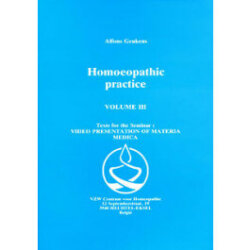Bundle I by Frans Vermeulen
This is a bundle of Vermeulen’s work that includes:
- Concordant Reference: Complete Classic Materia Medica 1st Edition
- Synoptic Reference: The First 500 Remedies
- Prisma: The Arcana of Materia Medica Illuminated
Concordant Reference: Complete Classic Materia Medica 1st Edition is a revised and updated Materia Medica of 1,209 remedies with expanded Sensation, Mind, and Dream sections. In this text, Vermeulen adds 362 remedies to his previous Materia Medica, Concordant Materia Medica. Concordant Reference 1st Edition includes family information and chemical formulas based on information from 10 reference Materia Medicas, published between 1790-1930.
The new Concordant Reference contains more information and more remedies and reflects the changes that have occurred in homeopathic techniques and scientific knowledge in recent years. Concordant Reference builds on the foundation of the classic Materia Medica from venerated authors, bringing it all into the modern world of contemporary homeopaths, addressing their needs for accurate information. The identity of remedy sources has been checked and verified, as well as corrected when needed.
The book includes:
- 1209 remedies including – Plants, Animals, Minerals, Chemical compounds, Drugs, Fungi, Protista, Imponderables, Nosodes, Sarcodes, Rocks and Waters
- 922 remedies have full, expanded sections (previous version – 847 remedies in 1600 pages)
- 287 small and largely unknown remedies from Boericke. These 287 remedies have been buried in Boericke and, by and large, contain very small amounts of information. Virtually hidden, they were rarely, if ever, used and therefore homeopaths had no chance to develop more information and clinical experience. The beginning of learning how to use a remedy is to know what it is and where it belongs. Giving these hidden remedies an accessible place, they can become more known and their usefulness expanded. As current experience in homeopathy demonstrates, often a small or previously unknown remedy can yield brilliant results.
- Remedy names have been upgraded to current scientific nomenclature standards.
- Each remedy has its Latin and common name.
- There are formulas for mineral and organic compounds.
- A family division is given for plants, animals, fungi, bacteria and viruses.
- The term ‘Classic Materia Medica’ refers to the work done from 1790 – 1931, starting with Hahnemann and ending with Boericke and Boger. After that, there was a gaping silence for about 50 years during which there was almost no new information. The homeopathy renaissance we are still experiencing began around 1980. Under all new developments is the foundation from the classic authors and their important original work.
Concordant Reference is a one volume compilation of the classic texts of:
- T.F. Allen – Handbook of Materia Medica and Homeopathic Therapeutics and [partially] Encyclopedia of Pure Materia Medica -10 volumes (1874 – 79)
- T.F. Allen – A Primer of Materia Medica
- Boericke – Pocket Manual of Homeopathic Materia Medica (1927)
- Boger – Synoptic Key of the Materia Medica (1931)
- Clarke – Dictionary of Homeopathic Materia Medica – 3 volumes (1900)
- Cowperthwaite – Textbook of Materia Medica and Therapeutics (1891)
- Hering – Guiding Symptoms – 10 volumes (1877 – 89)
- Kent – Repertory (1877)
- A. Lippe – Textbook of Materia Medica (1865)
- Pulford – Homeopathic Materia Medica of Graphic Drug Pictures (approx. 1930)
- Now added to the texts included in the previous Concordant are symptoms coming from T.F. Allen’s Handbook and his 10-volume Encyclopedia. The Sensation, Mind and Dream sections have been most enlarged, reflecting the recent developments in case taking, case analysis and prescribing that have shown to be so effective for today’s homeopath.
- The remedies most benefiting from the additional information are the medium-sized and small remedies. Polychrests are so well known, there was hardly anything new to add, even after scouring Allen’s Encyclopedia for additional symptoms. Until now, remedies that fell into the category of medium and small were relegated to reduced status because they were considered to be useful only in a narrow sense as being indicated for specific organs or for limited local symptoms.
- Those who have the existing Concordant will find the familiar general layout, sections, symptom divisions, and categories.
- Sections include – Generals, Mind, Dreams, Body areas, Modalities, Relations, Causations.
From the standard repertory body sections, the sections of ‘Food and drink’, ‘Heart’, ‘Limbs general’, ‘Limbs upper’, ‘Limbs lower’ are split out for easier reference.
There are three possible divisions in each section – Sensation, Pain, Objective.
Symptoms come from three sources – proving, intoxication and clinical.
Whereas formerly the emphasis was on symptoms from clinical observations, now by the addition of more proving symptoms, a better balance has been achieved. This has been made possible by the addition of Allen’s Encyclopedia which concerns solely provings and intoxications. - Previously, there were instances in which two remedies were lumped together because they were thought to be the same. For the first time in any materia medica, the Concordant Reference differentiates the two, assigning the correct symptoms to each one, allowing for more accurate prescribing. Examples of such pairs include:
- Rhus tox and Rhus radicans
- Bryonia alba and Bryonia dioica
- Aloe socotrina and Aloe ferox
Synoptic Reference: The First 500 Remedies
Synoptic Reference: The First 500 Remedies provides a concise but thorough overview of remedies, assisting overwhelmed students in their studies and busy clinicians in retaining essentials. 274 plants, 132 minerals, 64 animals, 18 nosodes, 10 fungi and 2 imponderables are covered in this very impressive volume.
Prisma: The Arcana of Materia Medica Illuminated
Prisma: The Arcana of Materia Medica Illuminated is a fully expanded version of Synoptic One, containing the same remedies, and also an encyclopedic amount of information on the source, zoology, chemistry, physics, distribution, folklore, mythology, and history of the remedies. This contextual material is absolutely fascinating reading, bringing the medicinal substances vibrantly to life. Whereas Synoptic One and Concordant Materia Medica are vital books for the student and the practitioner alike as clinical reference texts, Prisma is all this, plus bedtime reading too.




